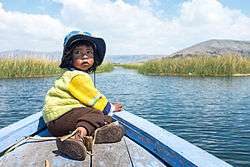
Uru people
The Uros (Uru: Qhas Qut suñi) are a pre-Incan people who live on forty-two self-fashioned floating islands in Lake Titicaca Puno, Peru and Bolivia. They form three main groups: Uru-Chipayas, Uru-Muratos and the Uru-Iruitos. The latter are still located on the Bolivian side of Lake Titicaca and Desaguadero River.
History
The Uros descend from a millennial town that, according to legends, are "pukinas" who speak Uro or Pukina and that believe they are the owners of the lake and water. Uros used to say that they have black blood because they did not feel the cold. Also they call themselves "Lupihaques" (Sons of The Sun). Nowadays, Uros do not speak the Uro language, nor practice their old beliefs but keep some old customs.
The purpose of the island settlements was originally defensive, and if a threat arose they could be moved. The largest island retains a watchtower almost entirely constructed of reeds.
The Uros traded with the Aymara tribe on the mainland, intermarrying with them and eventually abandoning the Uro language for that of the Aymara. About 500 years ago they lost their original language. When conquered by the Inca empire, they had to pay taxes to them, and often were made slaves.
Uroš
Uroš (Serbian Cyrillic: Уpoш) is a Serbian given name. Philologists identify its root with that of a medieval Church Slavonic term, urove (ѹрове), attested only in the plural form. This noun has been interpreted as "lords", because it usually appears in conjunction with velmõžie (велмѫжие) "magnates", as in the phrase велмѫжие и ѹрове "magnates and lords". The noun was probably borrowed from the Hungarian word úr, "master" or "lord". The suffix -oš in uroš is found in a number of Slavic given names, particularly those of the Serbs, Czechs, and Poles.
The name may refer to:
See also
References

Uroporphyrinogen III synthase
Uroporphyrinogen III synthase EC 4.2.1.75 is an enzyme involved in the metabolism of the cyclic tetrapyrrole compound porphyrin. It is involved in the conversion of hydroxymethyl bilane into uroporphyrinogen III. This enzyme catalyses the inversion of the final pyrrole unit (ring D) of the linear tetrapyrrole molecule, linking it to the first pyrrole unit (ring A), thereby generating a large macrocyclic structure, uroporphyrinogen III. The enzyme folds into two alpha/beta domains connected by a beta-ladder, the active site being located between the two domains.
Pathology
A deficiency is associated with Gunther's disease, also known as congenital erythropoietic porphyria (CEP). This is an autosomal recessive inborn error of metabolism that results from the markedly deficient activity of uroporphyrinogen III synthase .
External links
References
This article incorporates text from the public domain Pfam and InterPro IPR003754
Podcasts:

-
by Ours
-
by Ours
-
by Ours
-
by Ours
-
by Ours
-
by Ours
-
by Ours
-
by Ours
-
by Ours
-
by Ours
-
by Ours
-
by Ours
-
by Ours
-
by Ours
-
by Ours
-
by Ours
-
by Ours
-
by Ours
-
by Ours
-
by Ours
-
by Ours
-
by Ours
-
by Ours
-
by Ours
-
by Ours
-
by Ours
-
by Ours
-
by Ours
-
by Ours
-
by Ours
-
by Ours
-
by Ours
-
by Ours
-
by Ours
-
by Ours
-
by Ours
-
by Ours
-
by Ours
-
by Ours
-
by Ours
-
by Ours
-
by Ours
-
by Ours
-
by Ours
-
by Ours
-
by Ours
-
by Ours
-
by Ours
-
by Ours
-
by ERios
Bleed
by: OursShe won't mind, she's got bills to pay
She won't mind, because I come today
Its feels so wrong to be right
She sits tight, in a different way
Pulls my eyes with the words she say
To be is all that she desired
But they didn't love you in our time
Nobody wants you in your life
Bleed and they'll serve you, alive
Words confessed from a memory
I feel them at last when I sing of what used to be
And I sing along like a choir
If I say goodbye to love will it go away
If I say goodbye to love because its here today
And it feels so strong tonight
For the rest of our lives
Fearing the way that will keep us alive
I put my hands to the sky
Pray for a sign if I believed in a god
We lay with our hearts to the floor
Feel from the ground of the earth keep us warm
I put my hands onto your head
As I
Say goodbye to love
I Say goodbye to love
I Say goodbye to love
I Say goodbye to love
They didn't hold you
I cried
Nobody wants you in your life
Latest News for: uros
- 1
